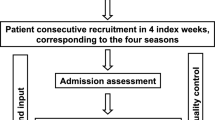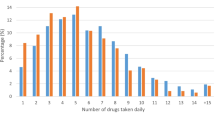Abstract
Purpose
To investigate the changes in the last decade (2000–2010) in drug prescribing among community-dwelling elderly people aged 65–94 years, in relation to age and sex.
Methods
We analyzed the data of nearly two million subjects ranging in age from 65 to 94 years recorded in the Drug Administrative Database of the Lombardy Region (Italy) from 2000 to 2010. Associations between drug use (at least one drug, one chronic drug, polypharmacy or chronic polypharmacy) and age, sex, and year of prescription were analyzed by logistic regression analysis. We also analyzed differences in changes linked to sex and age.
Results
Between 2000 and 2010, the prescriptions of at least one drug or one chronic drug increased by 2 % (from 88.0 to 90.3 %; p < 0.0001) and 8 % (from 73.8 to 82.0 %; p < 0.0001), respectively, while the mean number of packages/person/year rose from 34.6 [standard deviation (SD) 32.4] to 48.5 (SD 42.2). During this same period, there was a 10 % increase in the prevalence of elderly people exposed to polypharmacy (≥5 different active substances) (from 42.8 to 52.7 %; p < 0.0001), and the prevalence of those exposed to chronic polypharmacy (≥5 different chronic drugs) doubled (from 14.9 to 28.5 %; p < 0.0001). Males were less frequently treated than females, except for chronic polypharmacy. People aged ≥80 years showed the largest increase in all prescribing patterns. Drug consumption in ATC groups A, H, and N (women) and in B and C (men) increased most, with the greatest absolute differences occurring in the consumption of proton pump inhibitors (31.1 %), platelet aggregation inhibitors (30.1 %), and statins (23.8 %).
Conclusion
Prescriptions to community-dwelling elderly people have increased substantially during the last 10 years. Although this might indicate an improvement in care, the large increase in the number of elderly people exposed to polypharmacy and chronic polypharmacy should be carefully analyzed in terms of quality of care, patient safety, and costs.
Similar content being viewed by others
References
Istituto nazionale di statistica (ISTAT). Il futuro demografico del Paese. Previsioni generali della popolazione residente al 2065. Available at: http://www.istat.it/it/archivio/104818. Accessed 20 Nov 2012
Istituto nazionale di statistica (ISTAT). Natalità e fecondità della popolazione residente. Available at: http://www.istat.it/it/files/2012/11/nati-2011.pdf?title=Natalità+e+fecondità+della+popolazione+-+14%2Fnov%25. Accessed 20 Nov 2012
Nie JX, Wang L, Tracy CS, Moineddin R, Upshur RE (2008) Health care service utilization among the elderly: findings from the Study to Understand the Chronic Condition Experience of the Elderly and the Disabled (SUCCEED project). J Eval Clin Pract 14:1044–1049
Boyd CM, Darer J, Boult C, Fried LP, Boult L, Wu AW (2005) Clinical practice guidelines and quality of care for older patients with multiple comorbid diseases: implications for pay for performance. JAMA 294(6):716–724
American Geriatrics Society Expert Panel on the Care of Older Adults with Multimorbidity. Guiding principles for the care of older adults with multimorbidity: an approach for clinicians. Available at: http://www.americangeriatrics.org/annual_meeting/2012_meeting_handouts/amhandouts050512/guiding_principles050512. Accessed 30 May 2012
Fried TR, Tinetti ME, Iannone L (2011) Primary care clinicians’ experiences with treatment decision making for older persons with multiple conditions. Arch Intern Med 171(1):75–80
Gurwitz JH (2004) Polypharmacy: a new paradigm for quality drug therapy in the elderly? Arch Intern Med 164(18):1957–1959
Rosenthal MB, Berndt ER, Donohue JM, Frank RG, Epstein AM (2002) Promotion of prescription drugs to consumers. N Engl J Med 346:498–505
Chobanian AV, Bakris GL, Black HR et al (2003) The seventh report of the Joint National Committee on Prevention, Detection, Evaluation and Treatment of High Blood Pressure: the JNC 7 report. JAMA 289:2560–2572
Masoudi FA, Krumholz HM (2003) Polypharmacy and comorbidity in heart failure. BMJ 327:513–514
Lange RA, Hillis LD (2004) Antiplatelet therapy for ischemic heart disease. N Engl J Med 350:277–280
Garber AJ (2003) Benefits of combination therapy of insulin and oral hypoglycemic agents. Arch Intern Med 163:1781–1782
Tariot PN, Farlow MR, Grossberg GT, Graham SM, McDonald S, Gergel I (2004) Memantine treatment in patients with moderate to severe Alzheimer disease already receiving donepezil: a randomized controlled trial. JAMA 291:317–324
Anderson GF (2005) Medicare and chronic conditions. N Engl J Med 353:305–309
Wehling M (2009) Multimorbidity and polypharmacy: how to reduce the harmful drug load and yet add needed drugs in the elderly? Proposal of a new drug classification: fit for the aged. J Am Geriatr Soc 57(3):560–561
Townsed A, Hunt K, Wyke S (2003) Managing multiple morbidity in mid-life: a qualitative study of attitudes to drug use. BMJ 327:837
Corsonello A, Pedone C, Corica F, Incalzi RA (2007) Polypharmacy in elderly patients at discharge from the acute care hospital. Ther Clin Risk Manag 3(1):197–203
Nobili A, Marengoni A, Tettamanti M, Salerno F, Pasina L, Franchi C, Iorio A, Marcucci M, Corrao S, Licata G, Mannucci PM (2011) Association between clusters of diseases and polypharmacy in hospitalized elderly patients: results from the REPOSI study. Eur J Int Med 22(6):597–602. doi:10.1016/j.ejim.2011.08.029
Silwer L, Lundborg CS (2005) Patterns of drug use during a 15 year period: data from a Swedish county, 1988–2002. Pharmacoepidemiol Drug Saf 14(11):813–820
Hovstadius B, Petersson G (2013) The impact of increasing polypharmacy on prescribed drug expenditure-a register-based study in Sweden 2005–2009. Health Policy 109(2):166–174
Franchi C, Sequi M, Bonati M, Nobili A, Pasina L, Bortolotti A, Fortino I, Merlino L, Clavenna A (2011) Differences in outpatient antibiotic prescription in Italy’s Lombardy region. Infection 39:299–308
Franchi C, Tettamanti M, Marengoni A, Bonometti F, Pasina L, Cortesi L, Fortino I, Bortolotti A, Merlino L, Lucca U, Riva E, Nobili A (2012) Changes in trend of antipsychotics prescription in patients treated with cholinesterase inhibitors after warnings from Italian Medicines Agency. Results from the EPIFARM-Elderly Project. Eur Neuropsychopharmacol 22(8):569–577
Nobili A, Franchi C, Pasina L, Tettamanti M, Baviera M, Monesi L, Roncaglioni C, Riva E, Lucca U, Bortolotti A, Fortino I, Merlino L (2011) Drug utilization and polypharmacy in an Italian elderly population: the EPIFARM-elderly project. Pharmacoepidemiol Drug Saf 20:488–496
The Anatomical Therapeutic Chemical (ATC) classification. About the ATC/DDD system. WHO Collaborating Centre for Drug Statistics Methodology. Available at: http://www.whocc.no/atcddd/. Accessed 20 Nov 2012
Bajcar JM, Wang L, Moineddin R, Nie JX, Tracy CS, Upshur RE (2010) From pharmaco-therapy to pharmaco-prevention: trends in prescribing to older adults in Ontario, Canada, 1997–2006. BMC Fam Pract 11:75
Parabiaghi A, Franchi C, Tettamanti M, Barbato A, D’Avanzo B, Fortino I, Bortolotti A, Merlino L, Nobili A (2011) Antidepressants utilization among elderly in Lombardy from 2000 to 2007: dispensing trends and appropriateness. Eur J Clin Pharmacol 67(10):1077–1083
Tinetti ME, Bogardus ST Jr, Agostini JV (2004) Potential pitfalls of disease-specific guidelines for patients with multiple conditions. N Engl J Med 351(27):2870–2874
Califf RM (2009) Rational use of medications: if Canada can’t do it. CMAJ 181(1–2):15–16
Malone DC, Billups SJ, Valuck RJ, Carter BL (1999) Development of a chronic disease indicator score using a Veterans Affairs Medical Center medication database. IMPROVE Investigators. J Clin Epidemiol 52(6):551–557
Brilleman SL, Salisbury C (2013) Comparing measures of multimorbidity to predict outcomes in primary care: a cross-sectional study. Fam Pract 30(2):172–178
Competing interests
None.
Funding
This study was supported by grants from the Region Health Ministry of the Lombardy Region (Progetto ‘EPIdemiologia dei FARMaci’ – EPIFARM).
Ethics approval
All data were managed according to the current Italian law on privacy.
Author information
Authors and Affiliations
Corresponding author
Electronic supplementary material
Below is the link to the electronic supplementary material.
ESM 1
(DOC 89 kb)
Rights and permissions
About this article
Cite this article
Franchi, C., Tettamanti, M., Pasina, L. et al. Changes in drug prescribing to Italian community-dwelling elderly people: the EPIFARM–Elderly Project 2000–2010. Eur J Clin Pharmacol 70, 437–443 (2014). https://doi.org/10.1007/s00228-013-1621-6
Received:
Accepted:
Published:
Issue Date:
DOI: https://doi.org/10.1007/s00228-013-1621-6




